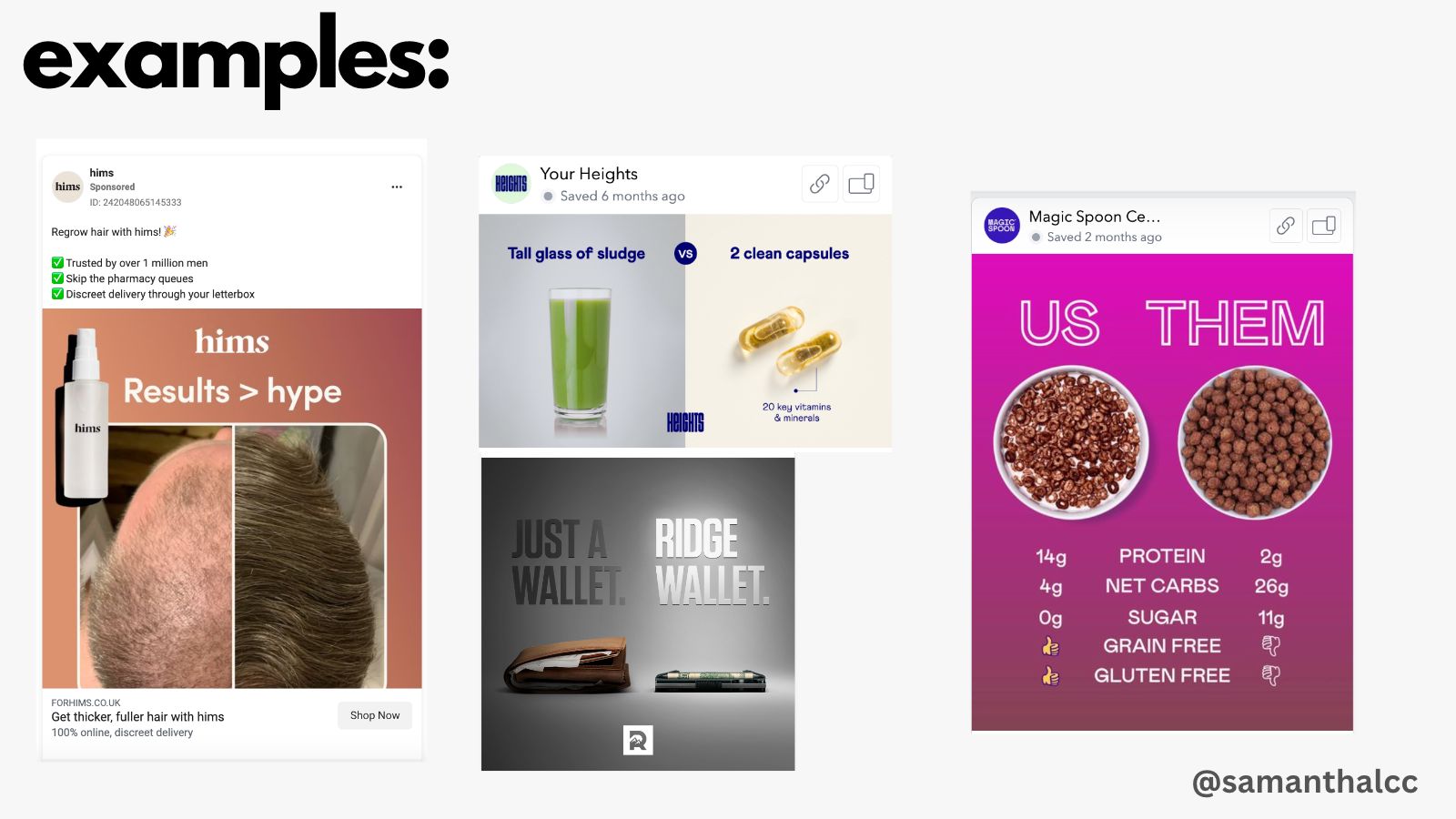A big thanks to our sponsors, who keep this newsletter free for all of you. Check them out—it's the best way to support this newsletter :)
Brought to you by CommonRoom. Check out their growth playbooks for tapping into the dark funnel — you know, that overlooked part of the buyer’s journey with heaps of potential. (Psst… they’re also sending swag to DC members who book a demo or sign up and connect a source).
And Insense—join leading mobile apps like Paysend, Flo Health, and Joy Organics that use Insense as their all-in-one platform for UGC, influencer partnerships, and whitelisted ads for Meta and TikTok.
Through their platform, you can build a roster of your favorite creators for long-term collabs, product seeding, and brand ambassadorships, and build a well-stocked creative library of raw footage, fully edited content, and B-roll for creative testing. Book a free strategy call today and get $200 for your first campaign by May 19.
|
Hello everyone, This week we're talking about comparing and contrasting, seeking groundedness, and five psychological principles to use in marketing.
Let's dive in!
As always, if you don't love this newsie, you can unsubscribe at the bottom of this email. Or, if you like what you see or have suggestions for improvement, you can leave us a review through the links in the footer.
–Neal |
|
|
1. Compare and contrast to highlight your value Insight derived from Samantha Leal. One of my favorite UX and marketing philosophies: "Don't make me think." When you vividly describe your product and the value it brings, you're helping people to imagine it and realize how it benefits them. You're doing the thinking for them. Visuals make that value even more obvious. Especially if you use those visuals to compare and contrast. |
For hims, the contrast of a balding head and a full head of hair paints a clearer picture than just a man with a full head of hair. You need to know the alternative. The before/after, or the "with vs. without."
For Ridge, that visual is a lot more powerful than saying, "Our wallets are 70% thinner." Because you see what "us vs. them" looks like, the comparison leaves an impact. Make your product's value obvious by showing what life is like without it. |
2. Connect your product to its place, people, and past
Insight from the Journal of Marketing (written by Grace). People seek groundedness—in their daily lives, and when they shop. - Place: We like buying locally. Near our homes and communities.
- People: We like knowing who we’re buying from. And relating to those people.
- Past: We like things that connect us to the past, like traditional production methods.
A Journal of Marketing study that brought groundedness into the realm of marketing (rather than its typical domains, philosophy and psych) uncovered some notable findings in the process. -
People who are more affected by digitization, urbanization, and disruptive events seek groundedness more. Including:
- People who are on their computers a lot for work
- People who live in big cities
-
People who felt more affected by the pandemic
- Groundedness increases willingness-to-pay. In one experiment, consumers were willing to pay a ~60% premium for a product that provided more groundedness.
-
Our need for groundedness might increase during birthdays and holidays, and it might even be higher during colder seasons. More research is needed to validate those points, but if they’re true, they could mean it's worth adjusting seasonal campaigns to focus more on the who and the where, not the what.
Takeaway: In your messaging, consider ways to build connections to place, people, and the past. Particularly if your customers work from home or in big cities.
That might mean emphasizing your product’s local origin, going with a more traditional design, finding local distribution channels, talking about who your founders are and what they value, or even having your team focus on building their personal brands. |
3. 5 psychological principles to use in marketing Insight from Neal O'Grady.
No matter how well you understand psychology, you're affected by it. Here are five psych principles to leverage in your marketing campaigns: 1. Halo Effect What it is: The tendency to attribute positive qualities to someone (or a brand) based on a favorable first impression or single positive trait.
Example: Patagonia is known for its commitment to sustainability, ethical manufacturing, and corporate social responsibility. So consumers feel good about shopping there, since they believe they're supporting a brand that contributes to the greater good. 2. Primacy Effect What it is: People are more likely to remember and give greater importance to information at the beginning of a sequence. Example: When a salesperson starts their pitch with a product's most impressive benefits, that info is what's top of mind for customers. 3. Negativity Bias What it is: The tendency to give more weight to negative experiences than positive ones, leading to pessimism and risk aversion. Example: A cybersecurity firm talks about the horrors of being hacked in one ad, and the cozy feeling of security in another. According to the negativity bias, the first ad would leave a stronger impression.
4. Framing Effect What it is: People's decisions and perceptions are influenced by the way information is presented to them.
Example: A subscription-based service highlights the cost per day instead of the monthly price, making it seem more affordable. 5. Priming Effect
What: Exposure to a stimulus influences a person's thoughts, feelings, or behaviors in response to a subsequent, related stimulus. Example: A nonprofit uses emotionally charged language and images in their fundraising campaign, eliciting empathy and increasing the likelihood of donations.
––– Like these? Check out seven more. |
|
|
News you can use: -
Microsoft opened up "new Bing" to Open Preview—meaning no more waitlist for its AI-powered search—and announced a bunch of new features and capabilities. Those include more visual answers (like charts and graphs) and the ability to export, share, or continue chats through multiple sessions.
-
Sounds like Google is planning their own search moves, moving away from “10 blue links” and toward more AI convos and short video. The goal: make search more “visual, snackable, personal, and human.” Meanwhile, a leaked Google memo lamented their standing in the AI “arms race.” “While we’ve been squabbling [with OpenAI], a third faction has been quietly eating our
lunch,” the author wrote. “I’m talking, of course, about open source.”
-
Quick rundown of recent notable product updates: Meta improved Facebook Reels personalization and discovery and previewed new AR Reels ads and Facebook Stories. Amazon’s TikTok-esque video shopping feed, Inspire, is now available to all US customers. YouTube is expanding Shorts and in-feed video ads into video reach campaigns, which use Google AI to improve reach. And they’re adding “for you” recs on channel pages.
Tool we recommend: respond.io* Talking to leads on WhatsApp can result in a 3x shorter sales cycle—but converting them and providing a great customer experience are the real challenge.
With respond.io, you can create dynamic workflows to manage leads on WhatsApp. It's easy to use and intuitive. And it can handle a high volume of WhatsApp inquiries without downtime/lag. Focus on what matters most: converting leads into loyal customers. Start your 14-day free trial →
*Sponsored by respond.io |
|
| Top new marketing jobs If you're looking for a top growth role, check out the opportunities below from our job board. |
|
|
What did you think of this week's newsletter?
Loved it | Great | Good | Meh | Bad
If you enjoyed this, please consider sharing it with a friend. These newsletters take hours to make each week, so it really helps when you share us with fellow founders and marketers.
Who's Demand Curve?
We’re on a mission to help make it easier to start, build, and grow companies. We share high-quality, vetted, and actionable growth content as we learn it from the top 1% of marketers. We democratize senior growth knowledge. How we can help you grow: -
Read our free playbooks, blog articles, and teardowns—we break down the strategies and tactics that fast-growing startups use to grow.
- Enroll in the Growth Program, our marketing course that has helped 1,000+ founders get traction and scale revenue.
Check out our Sprints: short video courses that are laser-focused on a topic in growth.
Want to build an audience of buyers? Join the waitlist for the Un-Ignorable Challenge. -
Are you a funded startup looking to grow? Our agency, Bell Curve, can be your strategic growth partner.
Get your brand in front of our audience by sponsoring this newsletter.
See you next week.
— Neal, Grace, Joyce, Dennis, and the DC team. |
|
| © 2023 Demand Curve, Inc. All rights reserved. 4460 Redwood Hwy, Suite 16-535, San Rafael, California, United States
Unsubscribe from all emails, including the newsletter, or manage subscription preferences. |
|
|
|



_01H00GZHY2N9M5Q1FFFXZZ3A5A.png)



